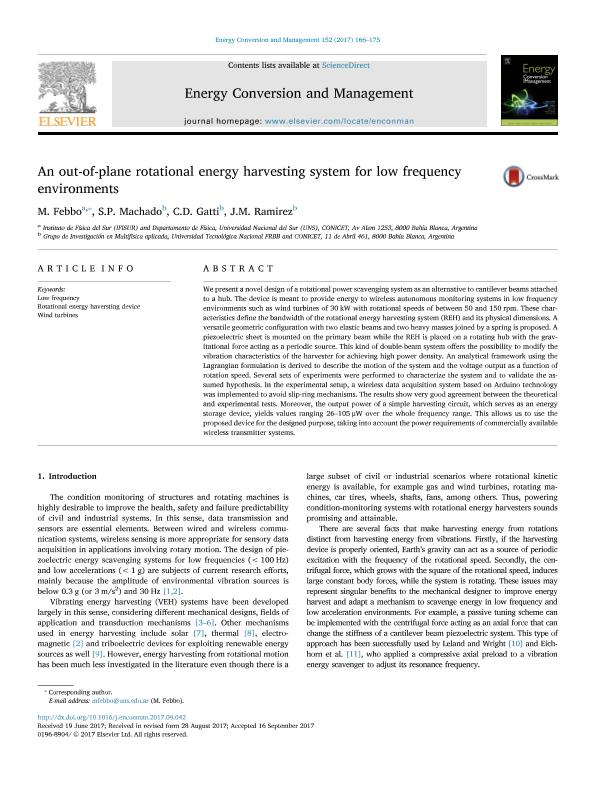Mostrar el registro sencillo del ítem
dc.contributor.author
Febbo, Mariano

dc.contributor.author
Machado, Sebastián Pablo

dc.contributor.author
Gatti, Claudio David

dc.contributor.author
Ramirez, Jose Miguel

dc.date.available
2018-10-31T17:56:04Z
dc.date.issued
2017-11-15
dc.identifier.citation
Febbo, Mariano; Machado, Sebastián Pablo; Gatti, Claudio David; Ramirez, Jose Miguel; An out-of-plane rotational energy harvesting system for low frequency environments; Pergamon-Elsevier Science Ltd; Energy Conservation and Management; 152; 15-11-2017; 166-175
dc.identifier.issn
0196-8904
dc.identifier.uri
http://hdl.handle.net/11336/63393
dc.description.abstract
We present a novel design of a rotational power scavenging system as an alternative to cantilever beams attached to a hub. The device is meant to provide energy to wireless autonomous monitoring systems in low frequency environments such as wind turbines of 30 kW with rotational speeds of between 50 and 150 rpm. These characteristics define the bandwidth of the rotational energy harvesting system (REH) and its physical dimensions. A versatile geometric configuration with two elastic beams and two heavy masses joined by a spring is proposed. A piezoelectric sheet is mounted on the primary beam while the REH is placed on a rotating hub with the gravitational force acting as a periodic source. This kind of double-beam system offers the possibility to modify the vibration characteristics of the harvester for achieving high power density. An analytical framework using the Lagrangian formulation is derived to describe the motion of the system and the voltage output as a function of rotation speed. Several sets of experiments were performed to characterize the system and to validate the assumed hypothesis. In the experimental setup, a wireless data acquisition system based on Arduino technology was implemented to avoid slip-ring mechanisms. The results show very good agreement between the theoretical and experimental tests. Moreover, the output power of a simple harvesting circuit, which serves as an energy storage device, yields values ranging 26–105 μW over the whole frequency range. This allows us to use the proposed device for the designed purpose, taking into account the power requirements of commercially available wireless transmitter systems.
dc.format
application/pdf
dc.language.iso
eng
dc.publisher
Pergamon-Elsevier Science Ltd

dc.rights
info:eu-repo/semantics/openAccess
dc.rights.uri
https://creativecommons.org/licenses/by-nc-nd/2.5/ar/
dc.subject
Low Frequency
dc.subject
Rotational Energy Haversting Device
dc.subject
Wind Turbines
dc.subject.classification
Ingeniería Mecánica

dc.subject.classification
Ingeniería Mecánica

dc.subject.classification
INGENIERÍAS Y TECNOLOGÍAS

dc.title
An out-of-plane rotational energy harvesting system for low frequency environments
dc.type
info:eu-repo/semantics/article
dc.type
info:ar-repo/semantics/artículo
dc.type
info:eu-repo/semantics/publishedVersion
dc.date.updated
2018-10-22T18:00:52Z
dc.journal.volume
152
dc.journal.pagination
166-175
dc.journal.pais
Estados Unidos

dc.description.fil
Fil: Febbo, Mariano. Consejo Nacional de Investigaciones Científicas y Técnicas. Centro Científico Tecnológico Conicet - Bahía Blanca. Instituto de Física del Sur. Universidad Nacional del Sur. Departamento de Física. Instituto de Física del Sur; Argentina
dc.description.fil
Fil: Machado, Sebastián Pablo. Universidad Tecnológica Nacional. Facultad Regional Bahía Blanca; Argentina. Consejo Nacional de Investigaciones Científicas y Técnicas; Argentina
dc.description.fil
Fil: Gatti, Claudio David. Universidad Tecnológica Nacional. Facultad Regional Bahía Blanca; Argentina. Consejo Nacional de Investigaciones Científicas y Técnicas; Argentina
dc.description.fil
Fil: Ramirez, Jose Miguel. Universidad Tecnológica Nacional. Facultad Regional Bahía Blanca; Argentina. Consejo Nacional de Investigaciones Científicas y Técnicas; Argentina
dc.journal.title
Energy Conservation and Management

dc.relation.alternativeid
info:eu-repo/semantics/altIdentifier/url/https://www.sciencedirect.com/science/article/pii/S019689041730866X
dc.relation.alternativeid
info:eu-repo/semantics/altIdentifier/doi/http://dx.doi.org/10.1016/j.enconman.2017.09.042
Archivos asociados
